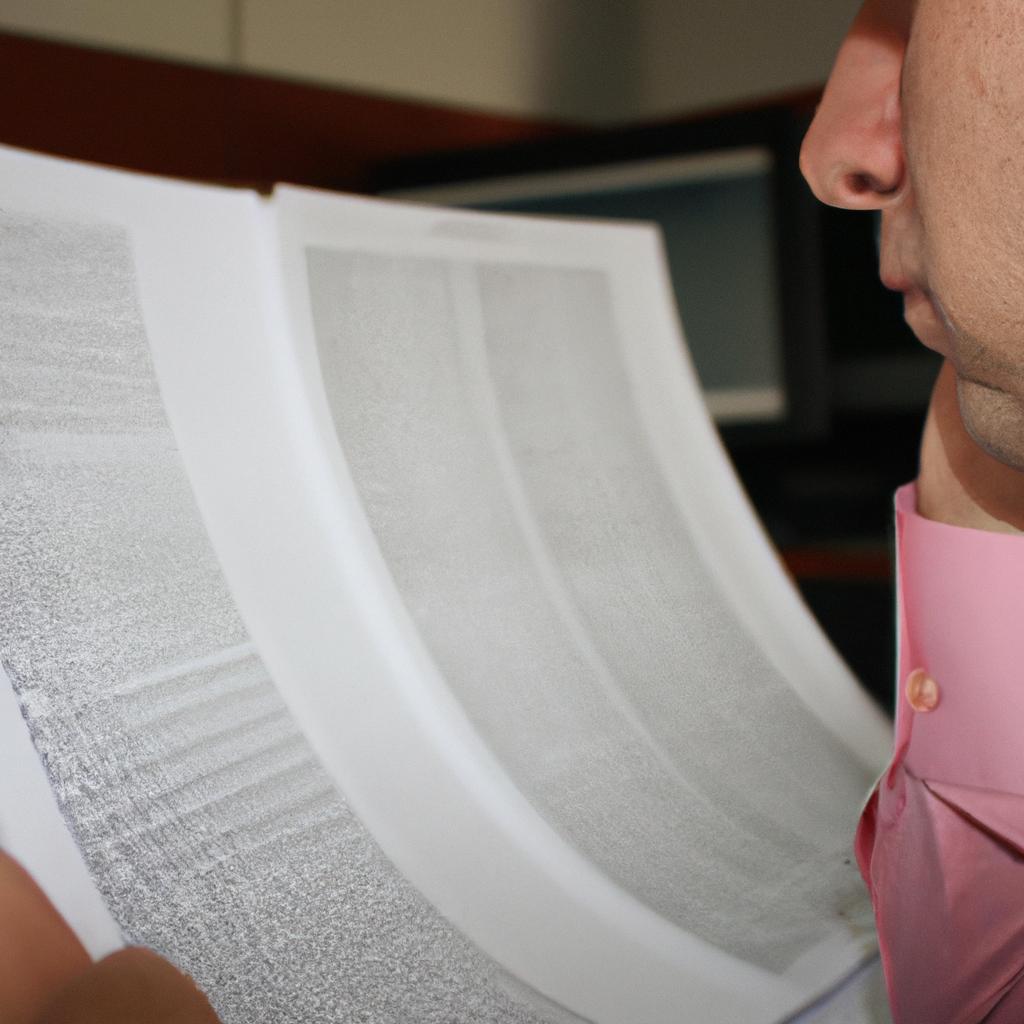Philosophical Financial: Aesthetics in the Realm of Financial Markets

In the vast and complex realm of financial markets, there exists a fascinating interplay between philosophy and aesthetics. While often overlooked or dismissed as inconsequential to the world of finance, the study of philosophical concepts can shed light on the underlying principles that govern market behavior and decision-making processes. This article aims to explore the intersectionality between philosophy and finance, specifically focusing on how aesthetic considerations influence investment strategies.
One compelling example that illustrates this connection is the case study of an investor who finds herself torn between two seemingly identical investment opportunities. Both options offer promising returns, but one aligns more closely with her personal values and ethical beliefs. In making her decision, she grapples with questions such as: What does it mean for an investment to be aesthetically pleasing? Can financial choices reflect our sense of beauty or harmony? By delving into these inquiries through a philosophical lens, we uncover a deeper understanding of the role aesthetics play in shaping financial decisions.
By examining various philosophical frameworks within financial markets, this article seeks to elucidate how individuals navigate their investments based on subjective notions of beauty, balance, and coherence. Through analyzing different schools of thought like utilitarianism, deontology, and virtue ethics, we gain insights into how investors incorporate moral values and aesthetic considerations into their decision-making processes. For instance, a utilitarian investor may prioritize maximizing overall societal welfare and seek investments that align with this goal. They may view aesthetically pleasing investments as those that contribute to the greater good and promote social harmony.
On the other hand, a deontological investor may adhere to ethical principles and rules that guide their investment choices, regardless of potential returns. Aesthetics in this context could involve investing in companies or industries that uphold certain moral standards, such as environmental sustainability or fair labor practices.
In addition to these ethical considerations, aesthetics can also play a role in the perception of risk and reward. Investors often rely on heuristics and gut instincts when making decisions, influenced by factors such as visual appeal, brand reputation, or intuitive judgments of quality. The aesthetic appeal of an investment can create a sense of trust and confidence or evoke caution and skepticism.
Furthermore, aesthetics can extend beyond individual investment decisions to shape broader market trends and behaviors. For example, financial products designed with visually appealing packaging or marketing campaigns may attract more investors, even if the underlying fundamentals are similar to less aesthetically pleasing alternatives. This highlights how aesthetics can influence market dynamics and potentially lead to mispricing or irrational investment behavior.
Ultimately, exploring the intersectionality between philosophy and finance through the lens of aesthetics allows us to understand the multidimensional nature of financial decision-making. By delving into questions about beauty, morality, and coherence in investments, we gain insights into how individuals navigate complex financial landscapes while aligning their choices with personal values and aesthetic preferences.
The Role of Aesthetics in Financial Markets
One might not immediately associate the concept of aesthetics with financial markets, but upon closer examination, it becomes evident that aesthetic considerations play a significant role in shaping investors’ perceptions and decision-making processes. For instance, consider the case of Company X, which recently announced a rebranding campaign featuring a sleek new logo and visually appealing advertisements. This strategic move aimed to enhance the company’s image and attract potential investors by conveying an impression of sophistication and stability.
In financial markets, aesthetics can be understood as the visual or sensory aspects that contribute to how investments are perceived. These aspects encompass various elements such as branding, design, presentation materials, and even the physical appearance of individuals representing companies or investment opportunities. By carefully curating these elements, market participants seek to create positive impressions among stakeholders and foster trust.
To better understand the multifaceted impact of aesthetics on investor behavior, let us consider several key points:
- Emotional resonance: Aesthetic appeal has the potential to evoke emotional responses from investors. The use of vibrant colors or engaging imagery can elicit positive emotions like excitement or confidence regarding an investment opportunity.
- Perception management: Companies often leverage aesthetics to shape how they are perceived by investors. Through deliberate choices in branding strategies, communication styles, and visual representations, they aim to position themselves favorably within the competitive landscape.
- Attention capture: In today’s information-rich world, capturing attention is crucial for attracting potential investors. Well-designed presentations or eye-catching marketing materials have higher chances of drawing focus amidst numerous competing options.
- Trust-building: Aesthetically pleasing visuals can help establish initial trust between investors and companies. When presented with professional-looking documents or visually cohesive websites, investors may perceive greater credibility and reliability.
Consider this hypothetical table showcasing different approaches to presenting investment opportunities:
| Investment Option | Traditional Design (Low Aesthetic Appeal) | Modern Design (High Aesthetic Appeal) |
|---|---|---|
| Option A | Minimalist layout with basic graphics | Dynamic design with visually stunning elements |
| Option B | Standard font and unremarkable colors | Unique typography and vibrant color palette |
| Option C | Dull presentation without visual hierarchy | Clear information architecture, engaging visuals |
In conclusion, aesthetics play a significant yet often overlooked role in financial markets. By considering the emotional resonance, perception management, attention capture, and trust-building aspects of aesthetic appeal, investors can better understand how these factors influence their decision-making processes. In the subsequent section, we will explore how aesthetics serve as a decision-making tool for investors.
Aesthetics as a Decision-Making Tool for Investors
In exploring the role of aesthetics in financial markets, it becomes evident that aesthetics can serve as a valuable decision-making tool for investors. By considering aesthetic elements such as design, branding, and visual appeal when evaluating investment opportunities, investors can gain insights into the potential success or failure of a particular venture.
For instance, let us consider the case study of Company XYZ, a start-up operating in the tech industry. Upon reviewing their investor pitch deck, an astute investor notices the meticulous attention paid to the design and layout of the presentation. The slides are aesthetically pleasing with consistent use of colors, fonts, and imagery. This attention to detail reflects not only on the company’s commitment to professionalism but also suggests their ability to execute tasks diligently.
The incorporation of aesthetics as a decision-making tool for investors is further supported by several key factors:
- Branding: Strong brand identity through effective logos, slogans, and overall visual representation contributes to consumer trust and loyalty.
- Emotional response: Appealing visuals elicit positive emotions from consumers and investors alike, fostering a sense of connection and engagement.
- Perceived value: High-quality aesthetics create an impression of quality and reliability associated with products or services offered by a company.
- Competitive advantage: In crowded marketplaces, businesses with well-designed materials stand out from competitors and attract greater attention.
To illustrate further how aesthetics can influence perception within financial markets, consider Table 1 below:
Table 1: Perception Comparison Between Two Companies
| Criteria | Company X | Company Y |
|---|---|---|
| Logo Design | Bold & Eye-catching | Generic & Plain |
| Website Layout | Modern & Intuitive | Outdated & Cluttered |
| Packaging | Sleek & Elegant | Uninspiring & Bland |
| Social Media | Consistent & Engaging | Inactive & Neglected |
From the table, it is evident that Company X’s aesthetics create a more positive perception compared to Company Y. This favorable aesthetic impression can influence investors’ decision-making process and potentially lead them towards investing in Company X.
In summary, aesthetics hold significant potential as a decision-making tool for investors within financial markets. By considering aspects such as design, branding, emotional response, and perceived value, investors can gain valuable insights into the prospects of an investment opportunity. The following section will delve deeper into how aesthetics influence market perception, shedding light on its impact beyond individual investment decisions.
The Influence of Aesthetics on Market Perception
While aesthetics may seem inconsequential in the realm of financial markets, their impact on market perception cannot be overlooked. Investors often make decisions based not only on rational analysis but also on aesthetic factors that influence their subconscious perceptions and emotions. To illustrate this point, let us consider a hypothetical scenario: imagine two companies in the same industry with similar financial performance metrics. One company has a visually appealing website, sleek branding, and modern office spaces, while the other lacks any visual appeal and appears outdated. Despite having comparable fundamentals, investors are more likely to perceive the aesthetically pleasing company as being more professional and innovative, potentially leading them to invest in it over its less visually appealing counterpart.
This example highlights how aesthetics can shape investor perceptions and subsequently impact investment decisions. The following bullet point list further underscores the various ways in which aesthetics can influence market perception:
- Visual design elements such as logos, colors, typography, and layout play a crucial role in shaping brand identity.
- Well-designed user interfaces for trading platforms or financial apps enhance ease of use and credibility.
- Office environments that reflect professionalism and attention to detail create positive impressions during client meetings.
- Advertisements that incorporate aesthetically pleasing visuals tend to capture attention and leave lasting impressions.
To delve deeper into the different aspects through which aesthetics influences market perception, we present a table outlining specific examples:
| Aspect | Example | Impact |
|---|---|---|
| Branding | Nike’s swoosh | Evokes feelings of athleticism and quality |
| Website Design | Apple’s site | Reflects simplicity and sophistication |
| Product Packaging | Tiffany & Co.’s iconic blue box | Symbolizes luxury |
Recognizing these influences is vital for both investors seeking accurate assessments of companies’ value propositions and businesses aiming to attract investments. By understanding how aesthetics affect market perception, stakeholders can leverage these insights to make informed decisions and design strategies that resonate with investor sentiments.
Transitioning into the subsequent section on “Aesthetics and the Emotional Aspect of Financial Decision-Making,” we explore how aesthetics intertwine with emotions, further shaping investment choices.
Aesthetics and the Emotional Aspect of Financial Decision-Making
The Influence of Aesthetics on Market Perception has shed light on how the visual appeal of financial products and services can shape investors’ perceptions. In this section, we will further explore the emotional aspect of financial decision-making and its connection to aesthetics in the realm of financial markets.
To illustrate this relationship, let us consider a hypothetical scenario where two investment firms offer similar mutual funds with identical performance records. The only difference lies in their presentation: Firm A presents their fund with an aesthetically pleasing logo, sleek website design, and visually appealing marketing materials; while Firm B lacks these aesthetic elements and instead focuses solely on providing comprehensive data about the fund’s performance.
In such a situation, it is likely that many potential investors would be drawn towards Firm A due to the positive emotions evoked by its appealing aesthetics. This example highlights how aesthetic factors can influence investor behavior even when rational decision-making should prioritize objective criteria like historical returns or expense ratios.
Research suggests several reasons why aesthetics play such a significant role in shaping our emotions and subsequent decisions:
- Visual attractiveness triggers positive feelings: Research shows that beautiful images activate reward centers in the brain, leading to increased positivity and higher engagement levels.
- First impressions matter: Just as we tend to form judgments about people based on their appearance within seconds of meeting them, investors often make quick assessments about financial products based on their initial visual impact.
- Emotional resonance enhances trust: When an investment product aligns with an individual’s personal values or aspirations through engaging visuals, it can create an emotional connection that fosters trust and confidence.
- Cognitive biases are at play: Humans are susceptible to cognitive biases such as the halo effect (attributing overall positive qualities to something based on one desirable trait) or confirmation bias (seeking information that confirms pre-existing beliefs). These biases can lead individuals to prefer aesthetically pleasing options without objectively evaluating other important factors.
Emotions triggered by aesthetics have been shown to significantly influence financial decision-making, often leading to a preference for visually appealing options over less aesthetically pleasing alternatives. This underscores the need for financial institutions and market participants to recognize the impact of aesthetics on investor behavior and incorporate it into their strategies.
In the subsequent section, we will delve deeper into the relationship between aesthetics and market behavior, exploring how aesthetic factors can shape market dynamics and investment trends. By understanding this connection, we gain valuable insights into how investors’ emotions interact with market forces, influencing both individual decisions and broader market movements.
The Relationship Between Aesthetics and Market Behavior
Section H2: Aesthetics and the Emotional Aspect of Financial Decision-Making
The emotional aspect of financial decision-making plays a significant role in shaping market behavior. Understanding how aesthetics influence these emotions can provide valuable insights into investor behavior and market dynamics. To illustrate this point, let us consider the case study of an investor named Sarah.
Sarah is considering investing in two different stocks: Company A and Company B. Both companies have similar financial prospects, but they differ aesthetically. Company A has a visually appealing logo, modern website design, and vibrant marketing materials that evoke positive emotions. In contrast, Company B’s branding is outdated with a dull logo and unimpressive website design. Despite their comparable financial outlooks, Sarah finds herself more attracted to Company A due to its aesthetic appeal.
This example highlights the impact of aesthetics on emotion-driven financial decision-making processes. Emotions such as attraction, trust, and confidence are often influenced by visual cues and sensory experiences associated with a company or investment opportunity. Here are some key ways in which aesthetics can elicit emotional responses:
- Visual Design: Eye-catching logos, pleasing color schemes, and well-designed websites can create positive first impressions and generate feelings of trust.
- Branding Consistency: Companies that maintain consistent aesthetic elements across various touchpoints convey reliability and professionalism.
- Packaging & Presentation: The way products or services are packaged and presented can shape consumers’ perception of quality and value.
- User Experience: Intuitive interfaces, user-friendly platforms, and engaging customer experiences enhance satisfaction levels.
To further explore the relationship between aesthetics and emotions in financial decision-making, we present the following table:
| Aesthetic Element | Emotional Response |
|---|---|
| Visually appealing logo | Attraction |
| Modern website design | Trust |
| Vibrant marketing materials | Confidence |
| Consistent branding | Reliability |
As visible from the table above, each aesthetic element evokes a specific emotional response. These emotions, in turn, influence investors’ perceptions and decisions when evaluating financial opportunities.
In the subsequent section on “Aesthetics and the Creation of Market Value,” we will delve deeper into how aesthetics can impact market value creation by examining the role of visual appeal in attracting investors and shaping market behavior. By understanding this relationship, market participants can gain insights into strategies that enhance aesthetic appeal to drive positive outcomes.
Aesthetics and the Creation of Market Value
In the previous section, we explored the intricate relationship between aesthetics and market behavior, highlighting how aesthetic factors can influence investors’ decision-making processes. Building upon that discussion, this section delves deeper into the role of aesthetics in creating market value.
One example that illustrates the impact of aesthetics on market value is the fashion industry. Consider a luxury brand known for its elegant designs and impeccable craftsmanship. The aesthetically pleasing products offered by this brand not only attract customers but also contribute to its perceived value in the marketplace. Consumers are willing to pay premium prices for these items because they appreciate their beauty and associate them with sophistication and style.
To further understand how aesthetics influences market value, it is important to examine specific ways in which aesthetic elements shape consumer perceptions:
- Visual Appeal: An aesthetically appealing product or environment captures attention and elicits positive emotional responses from consumers.
- Brand Image: Companies invest heavily in designing visually captivating logos, packaging, and advertisements to create a strong brand identity that resonates with their target audience.
- User Experience: Aesthetic considerations extend beyond physical appearance; they also encompass aspects such as user interface design in digital platforms or store layout in brick-and-mortar retail spaces.
- Social Influence: People’s perception of an item’s desirability can be influenced by social trends, cultural norms, and peer recommendations.
Table 1 below provides a visual representation of these key factors:
| Factors | Impact on Market Value |
|---|---|
| Visual Appeal | Attracts attention |
| Brand Image | Strengthens identity |
| User Experience | Enhances satisfaction |
| Social Influence | Shapes perception |
This table underscores the significance of aesthetics in shaping market dynamics and highlights how different aesthetic factors contribute to overall market value.
Understanding the interplay between aesthetics and financial markets enables stakeholders to make informed decisions and leverage the power of aesthetics to create value. By recognizing the impact of visual appeal, brand image, user experience, and social influence, market participants can strategically incorporate aesthetic considerations into their business strategies.
In light of these insights, it is evident that aesthetics play a crucial role in driving market behavior and determining market value. As we continue our exploration of aesthetics in financial markets, subsequent sections will delve deeper into specific industries where aesthetics have proven particularly influential.






